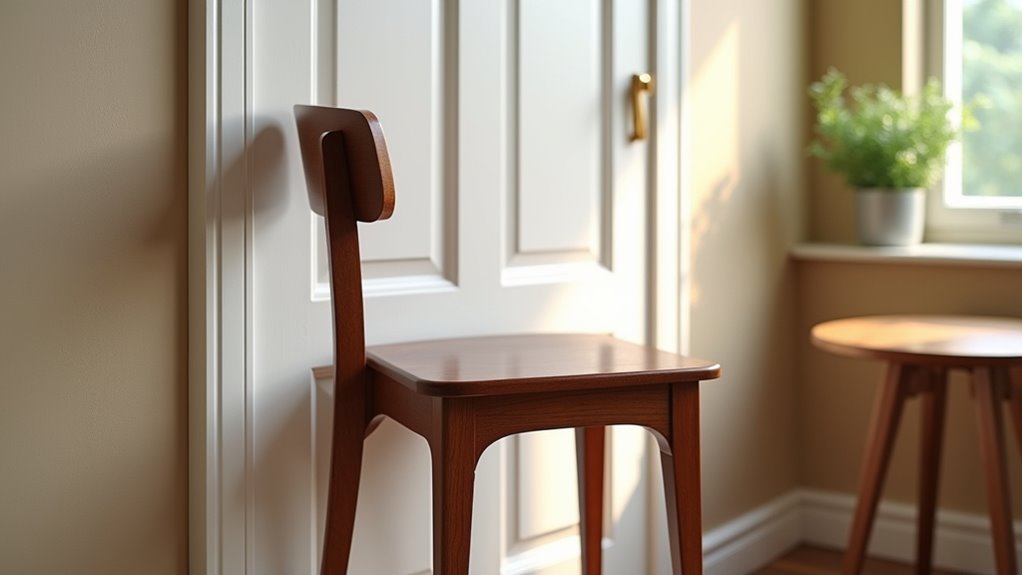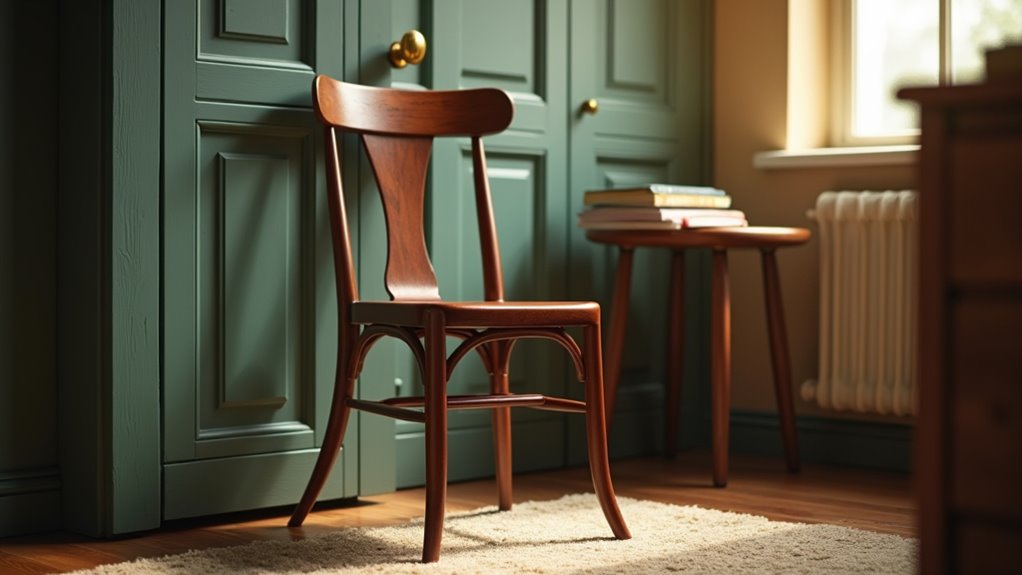How to Lock a Door With a Chair
This post contains affiliate links. As an Amazon Associate, we earn from qualifying purchases.
To lock a door with a chair, position the back leg of the chair against the door frame for stability, ensuring the seat faces away from the door to create strong pressure. If the door opens inward, slide the chair under the doorknob for additional support. Opt for a sturdy wooden or metal chair, but keep in mind that this method is not a substitute for a real lock. Further explanations and supporting details will follow for those interested in a deeper understanding of this technique.
Essential Facts in 30 Seconds
- Position the chair with its back leg against the door frame for stability.
- Use a sturdy hardwood or metal-framed chair for better strength.
- For inward-opening doors, slide the chair under the doorknob for added pressure.
- Ensure the chair is steady with legs spread for better grip.
- This method offers temporary security and may not engage the lock.
Understanding the Chair Placement Technique
Placing a chair to lock a door is simple yet effective. Start by putting the back leg of the chair against the door frame. This gives you strong support. Make sure the chair is steady. The back should face away from the door.
Next, position the seat away from the door. This helps create more pressure. For doors that open inward, slide the chair under the doorknob. This adds downward and outward pressure. Twist the chair a bit to secure it. The chair remains stable and secure once set. It’s like having a secret trick for safety!
Choosing the Right Type of Chair

Picking the right chair is key for securely locking a door. Not all chairs work well for this. Here’s what to consider:
- Chair Materials: Choose sturdy hardwood or metal-framed chairs. They’re strong and stay in place.
- Leg Design: Select chairs with thick, flat-bottomed legs or angled rear legs. These designs grip the floor tightly and offer great stability.
- Weight: Heavier chairs resist pushes better. Just make sure they’re easy to move when needed! In emergency situations, a chair can serve as a critical lockdown tool to enhance safety.
A good chair can make a big difference in safety.
The Physics Behind Chair Door Locking
Picking the right chair can really help with door security. Using a chair to lock a door works well. Wedge the chair under the door handle. This creates friction between the chair legs and the floor. That friction helps keep the chair in place. The angle of the chair matters too. When the legs spread out, they grip better. This makes it harder for the door to move. A simple chair can provide an extra layer of safety. It’s an easy and smart way to secure your space. Additionally, a chair can act as a makeshift door lock by utilizing the force of friction against the floor to prevent movement.
Ideal Situations for Using a Chair as a Lock

Using a chair to lock a door can be very helpful in certain situations. Here are some times when this trick works best:
- Emergency lockdowns: A chair can quickly block a door. It keeps unwanted guests out.
- Limited space: In small rooms with doors that open outwards, a chair fits well. It stops the door from swinging open.
- No heavy furniture: If there’s no heavy furniture around, a chair is a good choice. It makes a quick barricade.
A chair can give you temporary security when you need it.
Limitations and Considerations of Chair Locking
Using a chair to lock a door might seem smart, but it has big limits. Chairs rely on friction and balance. A strong push can easily move them. They only block the door, not engage the lock. Outward-swinging doors? They’ll win against a chair every time.
Safety is a major concern. Blocking exits with chairs breaks emergency rules. This makes it hard for people to escape during a fire or emergency. You don’t want to create trip hazards when fast exits are needed!
Think about legal issues too. Using a chair may go against building codes. This can cause trouble if someone gets hurt. A chair might seem like a fun idea, but think carefully before using it as a door lock.
Frequently Asked Questions
Can I Use a Stool Instead of a Chair for Locking?
A stool can be used instead of a chair for locking a door. But it may not be as stable as a chair. Stools can slip or tip over. This makes a chair a better choice for blocking a door. A sturdy chair provides more safety and support. Always choose what feels secure to you. A strong barrier is important for your safety.
How Long Can a Chair Barricade a Door Effectively?
A chair barricade acts like a quick shield. Its strength depends on how stable the chair is and where it is placed. The type of door also matters. A strong barricade can hold for a few seconds to several minutes. Determined intruders can still break through with enough force. Using a heavy chair against a solid door is best. Make sure the chair is pushed firmly against the door. This setup can buy you valuable time in an emergency.
What Should I Do if the Chair Slips?
A slipping chair can be a safety hazard. Reposition the chair quickly to make it stable. Ensure it has firm contact with the door. Check the type of door you have. Adjust your approach based on that. Use extra furniture for support if needed. This will help prevent more slippage. Always prioritize safety and stability.
Are There Any Specific Chair Brands Recommended for This Method?
Husky Office® chairs are a great choice for strong and durable seating. Their aluminum frame can handle a lot of weight. The non-slip foot pads keep the chairs stable. This makes them perfect for blocking doors. Choose these chairs for reliability and strength. They are built to last and can take pressure without damage. You can trust Husky Office® chairs for your needs.
Can I Use This Technique on Sliding Doors?
A chair won’t work for sliding door security. It can’t stop the door from moving sideways. For better protection, use locks or latches made for sliding doors. These tools provide stronger security. They keep your home safe from intruders. Remember, a simple chair won’t do the job. Choose specialized options for peace of mind.
Conclusion
Locking a door with a chair is a smart idea. Break-ins happen every 26 seconds in the U.S. That’s surprising! To secure your door, find a strong chair. Place it under the doorknob. This method adds an extra layer of safety. It’s not perfect, but it helps keep intruders out. Stay alert and protect your space! You’ve got this!
